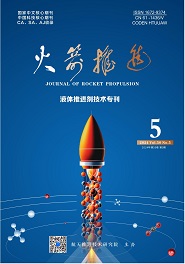航天推进技术研究院主办
SONG Jing-jing,WANG Hai-feng,ZHAO Hong-bo,et al.Analysis on blow-off test system for launch vehicle power system[J].Journal of Rocket Propulsion,2014,40(04):82-86.
动力系统试验吹除系统调试问题分析
- Title:
- Analysis on blow-off test system for launch vehicle power system
- 分类号:
- V434-34
- 文献标志码:
- A
- 摘要:
- 新一代运载火箭动力系统试验台首次承担某型号动力系统试验任务,在发动机燃料头腔(燃气腔)吹除调试过程中发现吹除压力偏低,难以满足试验要求。介绍了吹除系统组成及利用孔板模拟发动机吹除路背压的调试方案,分析了引起吹除路压力偏低可能原因是孔板模拟的额定吹除流量或供气管路的阻力系数偏大。因此,通过模拟孔板流量系数标定和管路流阻特性计算,最终确定供气管路阻力系数偏大是引起吹除压力值偏低的主要影响因素,并通过制定加大供气管路内径、减少系统阀门数量等针对性改进措施,优化了地面配气工艺系统。经试验验证:吹除压力偏低的原因分析是正确性的,采取改进措施后供气管路的流阻损失降低了47%。同时确定了试前气源的容积及充气压力,保证了试验的顺利进行。
- Abstract:
- First test of a certain launch vehicle power system was conducted at the new generation launch vehicle power system test stand. During the debugging of blow-off in the fuel dome of the engine, it was found that the blow pressure in the cavity was too low to meet the test requirements. Based on introducing the constitution of blow-off system and debugging method of utilizing the orifice plate to simulate backpressure in blow-off path of the engine, the causation of low pressure in blow-off path is analyzed, by which the reason is revealed that the resistance coefficient of the rated blow-off flow of orifice plate simulation or the air supply pipeline is too high. By flow coefficient calibration of orifice plate and the flow resistance calculation of the pipeline, it is affirmed that high flow resistance coefficient of the air supply pipeline is the main factor that leads to the low blow source were confirmed. The analysis results ensure the success of power system test. With the measures, the flow resistance loss was decreased by 47%.
参考文献/References:
[1]周载学. 发射技术(中)[M]. 北京: 宇航出版社, 1990.
[2]孙淮清. 流量测量节流装置设计手册[M]. 北京: 化学工业出版社, 2005.
[3]范瑞祥, 田玉蓉, 黄兵, 等. 新一代运载火箭增压技术研究[J]. 火箭推进, 2012, 38(4): 8-16.
[4]孙宏明. 运载火箭与推进系统[J]. 火箭推进, 2000, 38(3): 1-10.
[5]王池, 李芳, 王东伟, 等. 音速喷嘴检定过程中几个问题的分析[J]. 现代计量测试, 2002, 10(1): 24-27.
[6]齐利晓, 张涛, 邢娟. 正压法音速喷嘴气体流量标准装置的研究及应用[J]. 计量学报, 2009, 30(2): 125-129.
[7]梁国伟, 周宁宁, 李长武. 临界流文丘里喷嘴流量计的原理与应用[J]. 中国计量学院学报, 2004, 15(3): 186-190.
[8]许铃, 汪斌. 音速喷嘴气体流量标准装置测量不确定度评定[J]. 中国测试技术, 2007, 33(3): 63-64.
[9]郭霄峰. 液体火箭发动机试验[M]. 北京: 宇航出版社, 1990.
[10]廖少英. 液体火箭推进增压输送系统[M]. 北京: 国防工业出版社, 2007.
[11]流量测量不确定度分析[M]. 北京: 中国计量出版社, 2002.
[12]宋晶晶, 赵洪波, 孙德, 等. 高压大流量氢气稳压技术在试验中的研究与应用[J]. 火箭推进, 2011, 37(4): 64-70.
[13]廖少英, 顾仁年. 新一代运载火箭增压输送系统交叉输送技术研究[J]. 上海航天, 2005, 30(3): 37-41.
[14]张银勇, 吴剑, 李向党. 某推进系统气路启动特性研究[J]. 火箭推进, 2012, 38(6): 20-23.
[15]张雪梅, 朱佳春. 动力系统大气垫容积启动充填仿真及试验研究[J]. 火箭推进, 2012, 38(6): 1-4.
备注/Memo
收稿日期:2014-03-13;修回日期:2014-05-20 作者简介:宋晶晶(1982—),女,硕士,研究领域为火箭发动机地面模拟试验技术
